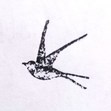Riftwar Re-Read #5 – Krondor
The 1990s were a glorious time for computer gaming, especially adventure games – text-based games had given way to Actual Graphics and 3D environments, and the industry was booming. This was the era of King’s Quest, Monkey Island and Myst – everyone wanted to get in on the action. And because a lot of these adventures were fantasy, some game companies started drawing on existing books.
You can probably see where I’m going with this. In 1993, Sierra released Betrayal at Krondor, the first in a pair of Riftwar adventure games. It was very well received – Game of the Year territory for a few magazines. The follow-up, Return to Krondor (1998), was apparently a bit rubbish, but so it goes.
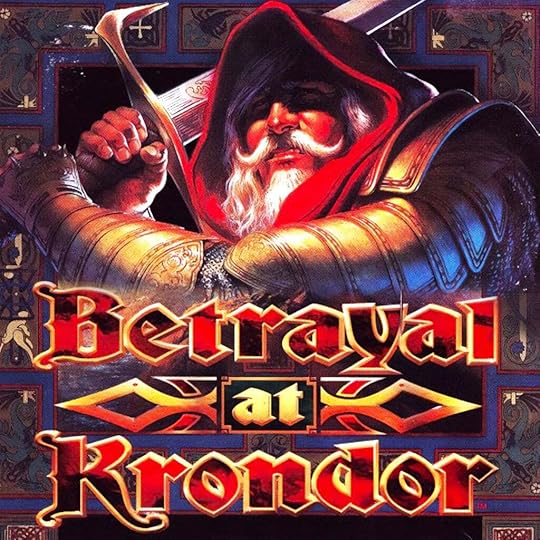 I think this is supposed to be Gorath the dark elf. Judging by the description in the book… well.
I think this is supposed to be Gorath the dark elf. Judging by the description in the book… well.I haven’t played these games – yet. I’m definitely going to. But I have read them. Because while Feist didn’t write either game, he did turn them both into novels. He also wrote an interquel book to fill the gaps between them, and when the third game in the series was cancelled he did a novella to tie up the loose ends too. These I have read – and they’re alright.
Like the Legends of the Riftwar books, the Krondor trilogy were published out of chronological order. They’re set about a decade after Sethanon, but a good 7 or 8 years before Prince of the Blood, the next entry in the series. Prince Arutha is well established as ruler of Krondor – he doesn’t feature much in the plot, though. Feist had already passed the torch to the next generation, Arutha’s children (shown here as happily running round the palace as kids do), in Prince of the Blood, and for the most part he doesn’t go back on that. What he does do, however, is take the opportunity to expand on some other characters. That’s right: it’s the Jimmy and Locklear show.
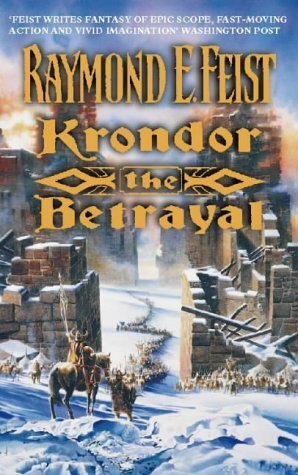
Krondor: The Betrayal (the novelisation of Betrayal at Krondor) has a wide group of POV characters as a necessary consequence of being based on a game with a wide group of player characters. At the forefront, though, is Squire Locklear, a minor character from Silverthorn and Sethanon who’s now all grown up and buckling his own swash. He’s a nicely written dashing rogue, mostly in the company of Owen, a young magician who’s presented quite well as powerful but out of his depth, and Gorath, who’s one of my favourite one-off characters in the series. He’s a dark elf, a group who’ve been entirely antagonists in the series so far – but Gorath has gone rogue and joined the good guys, while still being nicely morally ambiguous. His internal conflict between his own people – the rest of whom are the bad guys in this book – and his own morality is well-realised, and it’s also a welcome sight to have dark elf society depicted as, well, a society, with its own distinct culture. We get to see actual societal reasons behind all the marauding and invading, and a degree of acceptance from the human Kingdom. I didn’t expect to find this hidden away in a game novelisation, but it was a pleasant surprise.
Plot-wise it’s a simple affair, and one tied tightly to Sethanon: the dark elves are invading, again, to seize the power of the Lifestone left behind at the end of the original trilogy, supported by various elements of dark conspiracy in the Kingdom. Most of the characters are veterans of that first war too. I pity whichever gamers picked this up without having read the first Riftwar trilogy. Our heroes thwart the invasion, having some nice character moments along the way, and it’s all wrapped up in time for tea and medals.
On its own, that’d be fine. But, unfortunately, this is very clearly the book of the game, to its detriment. The story meanders through the Kingdom, diverging constantly on what must have been actual side-quests that aren’t really relevant to the plot no matter how hard Feist tries to make them so. 1 in 3 chapters seems to end on a character finding a magical item and going ‘oh interesting, I’m sure this will be useful later’, and putting it away. That’s not a chapter hook, Feist. There’s a whole sequence at the end where the magician characters are trapped on a mysterious island and have to wander around physically picking up mana to recharge their magic gauges. The description also suffers enormously: half the environments barely get a sentence before it’s time for another conversation. The Betrayal is far too tightly tied to its origin as a game to be a good book in its own right.
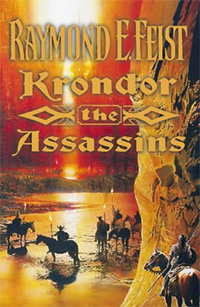
This is only more apparent when you read Krondor: The Assassins. Because The Assassins wasn’t based directly on a game, but was intended to fill the gap between the first two games. And because of that, it’s a far better book. Jimmy the Hand – now Squire James of Arutha’s court – goes after the various assassins and conspirators who were hinted at in The Betrayal supporting the dark elf invasion, culminating in a dramatic showdown in the desert between Arutha, Jimmy, and a bunch of demon assassins. This book is everything a retroactive filler book should be. We get to see Jimmy the Hand properly transitioning from the boy thief of the first books to the politician and spymaster he’ll ultimately become. Jumping from Sethanon to Prince of the Blood skips over a lot of development that Feist masterfully reinserts in The Assassins. I get the feeling he enjoyed going back to a younger Jimmy. Another character who’ll turn up more prominently in later books is William, son of the magician Pug and career soldier, who serves as Jimmy’s muscle. He’s a fun character: good at what he does but with a chip on his shoulder from not being a magician like his father. He and Jimmy work very nicely together and it makes the book very fun to read. And at the end, we get one last hurrah for Prince Arutha himself, who throws himself into a nice bit of demon-fighting like he never gave it up.
The Assassins doesn’t feature all the videogame nonsense of The Betrayal: there are no obvious side-quests or MacGuffins (or if there are, they’re worked far more elegantly into the story than the first book), which leaves space for a more in-depth look at the setting. Krondor is a big city, and it’s always an important one throughout the Riftwar series. This is the first book to spend almost all of its time there, and it turns the place into a really well-realised setting. As you might expect, given the trilogy is named after it.
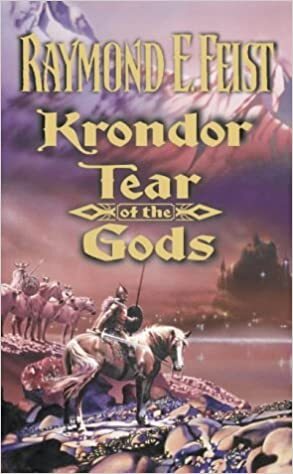
Tear of the Gods is based on the second Krondor game, but, thankfully, Feist writes it more in the vein of The Assassins than The Betrayal. Jimmy and William are once again the main protagonists, joined now by magician Jazhara, who provides a nice balance to the other two, being somewhat arrogant but passionate with it. Following more or less directly from the plot of The Assassins, it’s half intrigue in Krondor to continue rooting out the existing conspiracy, and half dramatic quest to save the magical Tear of the Gods from being corrupted by dark magic. Now, while you can again tell that it’s based on a videogame – there are several prominent Important Items, and a bit towards the end where the party tramp back and forth from a village to a witch’s hut for Plot-Advancing Conversations – it’s much better than The Betrayal. Some of the scenes are actually very well handled: there’s a moment where Jimmy has to solve a magical puzzle lock that’s clearly just a puzzle from the game, but Feist is a little tongue-in-cheek with it and it’s rather funny.
There’s also definitely an advantage in William and James having already been set up as characters in the previous book: Feist can have their story threads continue from before rather than having to set it all up at once. It helps plot-wise too, as there’s no need to introduce the shadowy Crawler or the goings-on in Krondor again, allowing the action to start straight away. It’s far from perfect, as the videogame-ness begins to show particularly at the end, when everything comes together into a very clear boss fight, but even those scenes are able to serve an emotional plot purpose. It’s no The Assassins, but Tear of the Gods is at least better than The Betrayal.
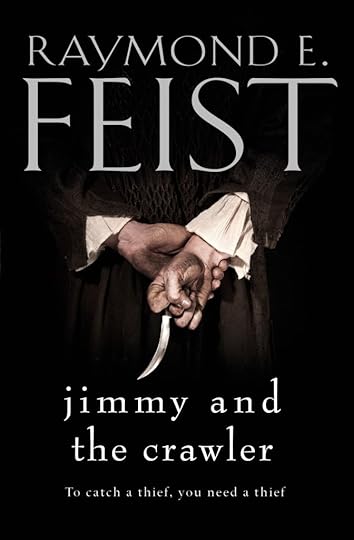 Alas, gloriously 90s cover art, we will miss you.
Alas, gloriously 90s cover art, we will miss you.We then come to the last bit of the story: Jimmy and the Crawler. This is to my knowledge the only novella in the series – apparently there were originally going to be 5 full books and a third game, but after Return to Krondor flopped it all got shelved, so Feist salvaged some of the plot and tied things up with Crawler. As it’s much shorter, there’s less room for grand description and extraneous story elements, which does keep everything tight. It’s clear that Feist had a list of things to do, though: tie up the stories of William and Jazhara, give closure to the Crawler storyline of the game (i.e. establish who this shadowy presence actually is), and add a little more to Jimmy’s journey from thief to spymaster. Off to the desert city of Durbin the trio go, therefore, chasing the last remnants of the Crawler’s network while Jimmy establishes a network of his own. We get some lovely rooftop sneaking, some tense battles in the underworld with demons and assassins, a not-entirely-unexpected romantic plot, and everything tied up neatly with the unmasking of the Crawler and everyone’s return to their proper places for Prince of the Blood and the continuation of the series proper.
Jimmy and the Crawler does the job. I do feel it could have done with being longer – the romance plotline in particular, while hinted at in Tear of the Gods, is started and finished in the space of about 50 pages. Feist clearly had grander plans for this bit of the story. But at least there is closure. It’s not a perfect ending to the arc, but it is an ending, and it’ll do.
The whole Krondor trilogy-and-a-bit is very much a filler arc. Obviously Feist had little room to deviate from the story he’d already set up – by the time Return to Krondor was released, Feist had already published the entire Serpentwar saga, meaning that he was 6 books ahead of the point in the timeline where Krondor takes place. But while Betrayal is weak and Crawler is too short, it’s still a fun enough read, especially if, like me, you’re a sucker for any Jimmy the Hand content you can get. Assassins and Tear of the Gods make it a worthwhile endeavour. You won’t miss anything by not reading them (though there are a few sneaky scenes that actually set up a villain from much later in the cycle that I was surprised by in this re-read). But you might as well. They’re a bit of fun.
Maybe it’d be a better idea to play Betrayal, read Assassins, and then play Return. I’ll let you know when I’ve done it – because I’m certainly going to give it a try.

